Sailing For Beginners
Emma Coady shares her experience of learning to sail a dinghy.
July 30, 2025
Learning to sail
Living inland in the bucolic Cotswolds, learning to sail felt like a distant dream. A sailor whom I recently interviewed recommended learning to sail on a lake. The UK has a bounty of beautiful hidden pockets of freshwater lakes and reservoirs that are safer to learn sailing on than by the sea. Tides and coastal factors can play havoc in your mind when you are trying to learn the basics of wind direction. After hearing about Ocean Cruisers Andy and Hiba's exciting adventures at sea, I decided it was time to get myself out on the water and signed up for a RYA Level One sailing course at Banbury Sailing Club. The club came recommended to me by a friend who highly rated their kids club.

Above: Banbury Sailing Club is renowned for its kids club. Image via Banbury Sailing Club.
Banbury Sailing Club: A Golden Training Ground
Although I was not consciously nervous, the night before arriving at the club I dreamed that I was sailing, capsized and found orca whales at the bottom of the lake.
Arriving at Banbury Sailing Club I was excited to get out on the water. Our instructor, Andrew Rimmer, had been sailing since he could stand.
How do sails work?
In the classroom Andrew used a graphic and a toy yacht to help us understand how sails work in relation to the force of the wind. More of a literary soul- I found the practical and theory that sailing entails a challenge.
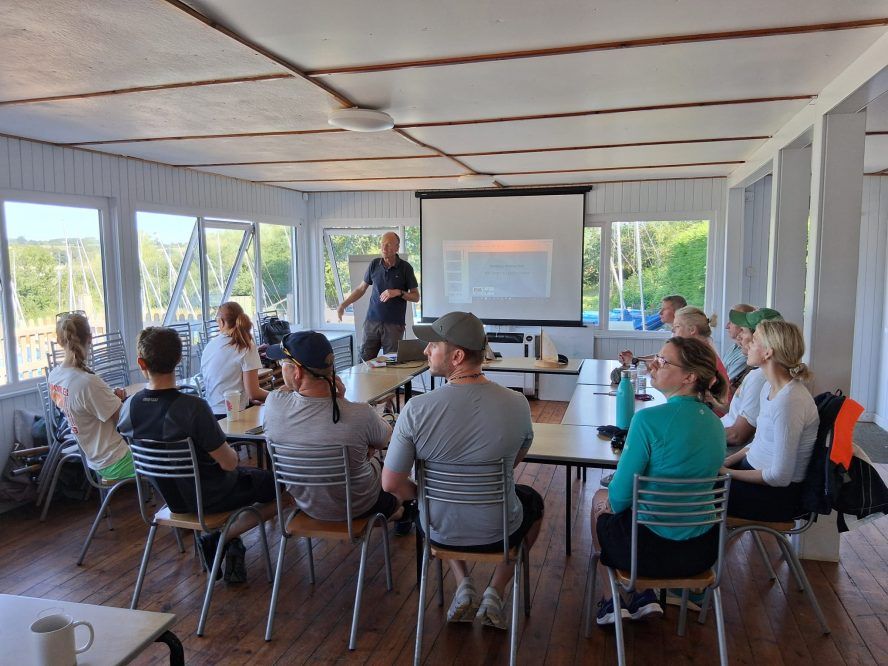
Above: Looking out to the water. Image via boats.com
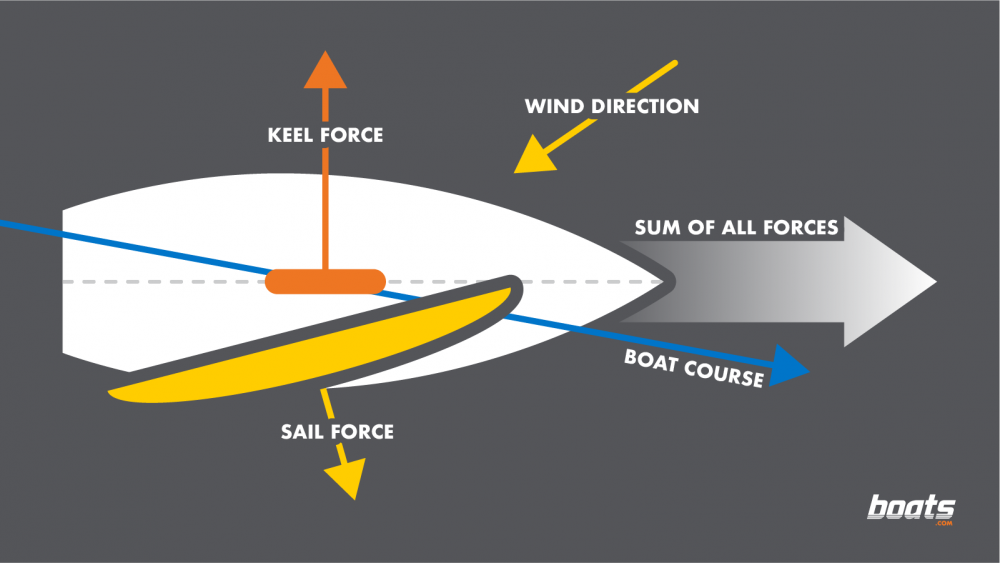
Above: How a sail works. Image via boats.com
Portside and starboard
For those that do not know, the starboard side of a vessel is on the right-hand side when facing the bow (front). The left side is the portside. Thanks to my love of wine, this terminology sank pretty quickly. Port is traditionally passed to the left around a table.
Understanding wind direction
Andrew explained that there are several ways to identify the direction of the wind. A good reference is taking a moment to feel where the wind lands on your face. Then, look at the sailing club's flag. Wherever the flag is pointing is where the wind is coming from and going towards. The wind hits the post and enters the flag at the widest point and moves through the flag.
Another way at working out wind direction is by looking at the two tell-tale pieces of yarn tied to the rigging doing downwind. The string should be pointing horizontally along the gib. I found this incredibly helpful and found myself a little fixated on the tell-tales rather than keeping one eye out on-watch for oncoming traffic.
Watch this video for a masterclass on how to read the surface of the water to work out wind direction.
Rig & launch
Before we could get out on the water we needed to learn the basic theory of sailing. First, we worked on the anatomy of a boat, parts of a sail and ropework. We were handed ropes, which I later learned are referred to as sheets. Andrew Rimmer and the other instructors demonstrated how to tie three main types of knots, each required as part of basic seamanship. This enabled us to rig the boat and tie it up to the shore. The three main types of knots we learned were a full turn and two and a half hitches, a figure of eight and a reef knot.
Read 8 marine knots every boater should know
Preparing the boat to sail
Beginners can be put off sailing because they find rigging a sailboat intimidating. Unless you are technically minded and practical, you may find yourself feeling overwhelmed by trying to remember everything at once.
The process of attaching and hoisting the sails is known as rigging. Our instructors demonstrated how to attach the sails in ready for hoisting them up.
You must point the boat exactly into the wind before hoisting the mainsail so that it can flap freely. The mainsheet and kicking strap must be completely slack before hoisting the mainsail. You may choose to hoist the mainsail once the boat is afloat.
Give me a saddle and a bridle and I can tack on a horse in minutes. But rigging a sailboat looked complicated. The amount of knots we were expected to thread, tease and tie, had me in a spin. Every rope looked the same. I was not even on the water yet and feeling slightly out of my depth.
Points of sail (Angle to the wind)
Andrew explained how the wind affects the boats performance in different positions, enabling us to adjust the main sail, tinker with the gib and turn to reach our destination in a safe and efficient way. It all looked very straightforward in the water I found it hard to orient where the boat was in relation to the wind, since it chopped and changed direction frequently. I was doing mental gymnastics and forced to rely on my coaches instructions. Fortunately, they were very patient and calm.
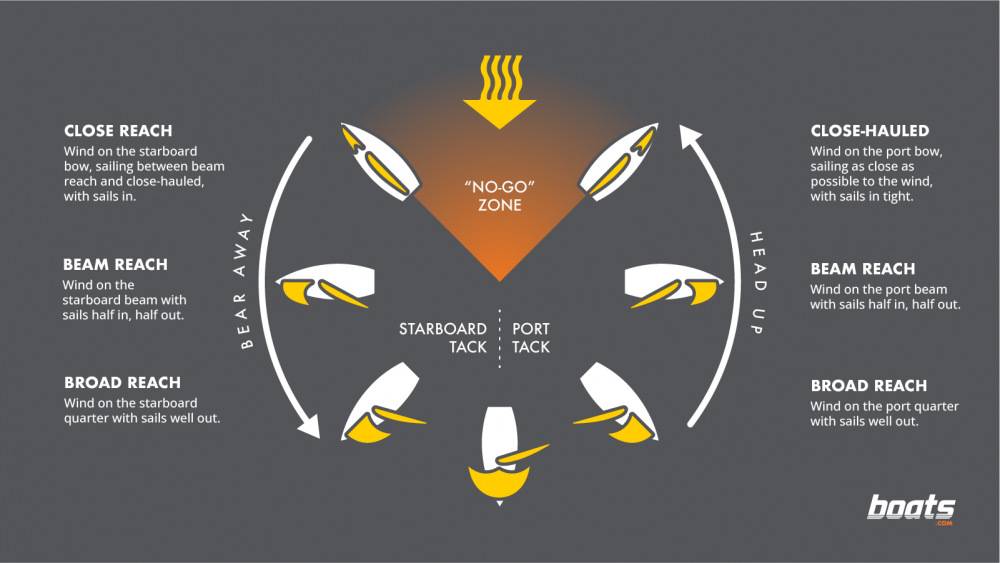
Above: Points of sail. This graphic demonstrates the different directions on a sailboat can travel relative to the wind. These directions are described as angles between the boat's course and the wind direction.
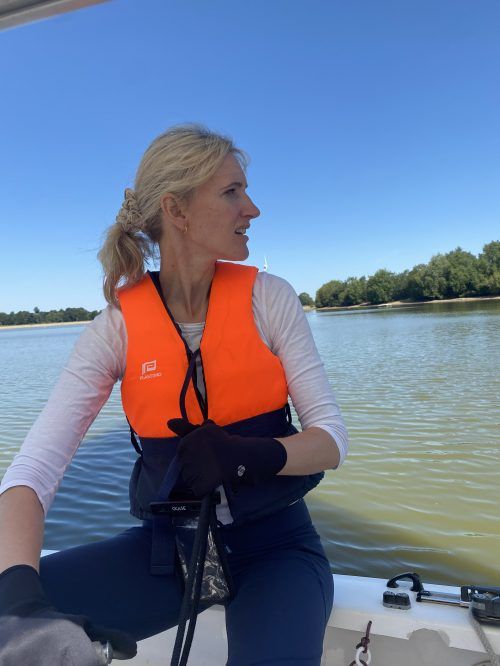
Above: Emma in a dinghy looking for oncoming traffic. Image via Emma Coady.
Foreseeing a gust
Gusts are a little tricky to get to a handle on. Watching the water's surface will help you to pre-empt a gust. Our instructor assured us that after a while we will be able to spot a gust on the water before it reaches us. When approaching a gust, you need to let the sails out before it hits the boat.
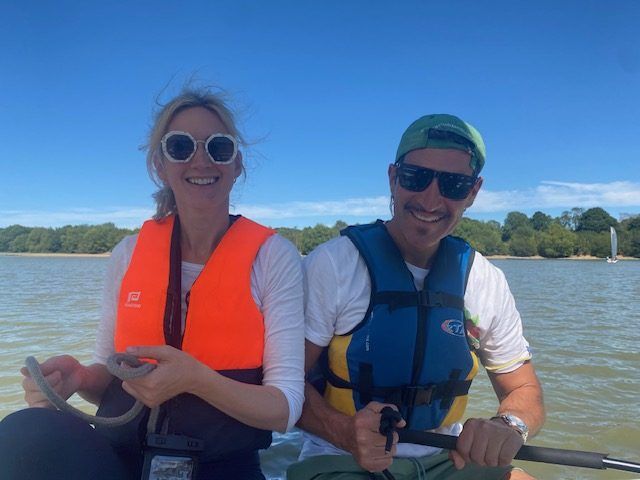
Above: Emma and Mal on a dinghy at Banbury Sailing Club. In this photograph we are gloriously unaware that we were about to capsize. Isn't that part of the fun? Image via Emma Coady.
Right of way/Rules of the road
When two sailboats are passing, the boat on a starboard tack has right-of-way over a boat on a port tack, and if they are both on the same tack, the windward boat gives way to the leeward boat.
While we learned the theory of this in the classroom, out on the water, I needed time to digest information before boats approached us. There were too many factors to consider in a matter of split seconds. Fortunately, our instructor made the decisions on our behalf to avoid a collision.
Moving through the water, I felt a sense of elation and a big sense of achievement when I completed my tacking turns. There were no noisy engines, or toxic fumes. I have cruised on a powerboat, but nothing comes close to feeling of being propelled through the water by harnessing the power of the wind.
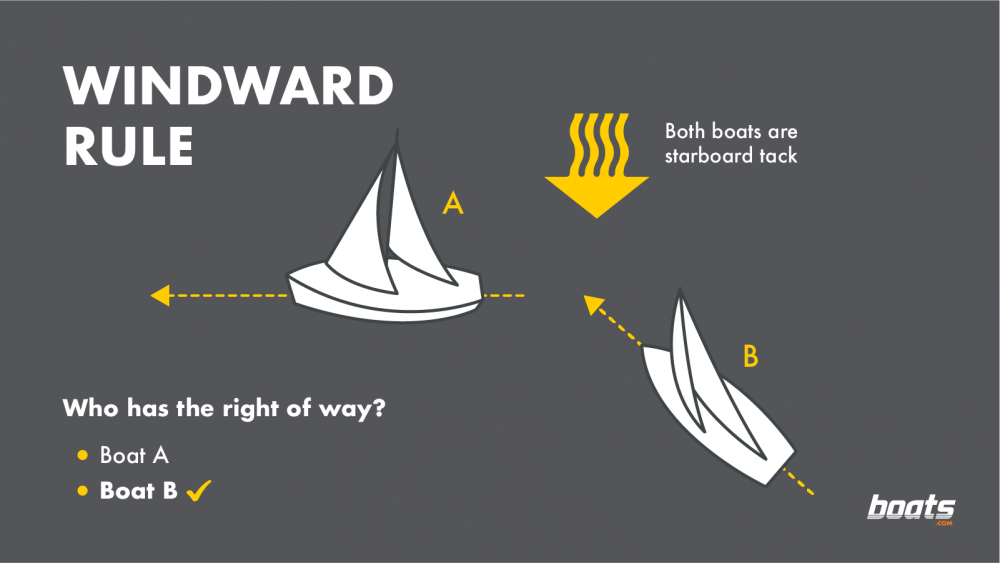
Above: Rules of the road. Image via boats.com
Understanding basic sailing terminology
Something I found a little bit confusing on the course were the casual wind references that our instructors slipped into conversation. Here is a breakdown of the terms you can expect to understand on the open water.
Windward
Towards the direction from which the wind is coming. The windward side of a boat or object is the side facing the wind. Sailing to windward means sailing as close to the direction of the wind as possible, which is typically achieved by sailing on a close-hauled course.
Ashore
To or on the shore or land from the direction of the sea.
Leeward
Situated on or towards the side sheltered from the wind.
Upwind
Upwind sailing, also known as sailing close-hauled or beating, refers to the act of sailing a sailboat as close to the direction the wind is coming from as possible, typically at an angle of about 45 degrees.
Downwind
Downwind generally refers to sailing with the wind coming from behind the boat, allowing it to travel in the same direction as the wind.
Coming alongside
Coming alongside in sailing refers to the maneuver of bringing a sailboat alongside a dock, pontoon in a controlled manner to moor.
Land drill tacking
Andrew demonstrated a tacking maneuver and how to interact with your crew ashore.
When you push the tiller handle extension away from you while you are sailing it is called tacking. Facing forward, push the tiller across. As soon as the rudder is hard over, pass the extension across forward and re-centre the tiller.
Whilst it looked easy in practice, but when the tiller was in my hand, moving it back to centre while holding the main sail rope and keeping my body facing forward was a co-ordination challenge.
Steps of a tacking maneuver
The helmsman asks, “Ready about?”
- The crew looks 360° around the boat, for oncoming traffic gets ready to jibe. If the area is clear, the crew replies, ”Ready.”
- “Lee-ho!” The helmsman chants before lunging across the boat with careful attention given to the tiller positioning.
- The helmsman steers the boat, turning the boat towards the wind, initiating the turn.
- The crew releases the jib. As the boat turns, the jib will start to luff (flap) as it loses wind.
- Trim the jib. The crew quickly trims the lazy jib sheet to pull the jib across to the new side of the boat.
- The helmsman will adjust the mainsail to the new wind direction, easing or trimming the mainsheet to align the sail with the new course.
- Duck as the boom swings across the boat
- Continue turning. The helmsman continues to steer the boat through the wind until it is on the new course.
After the tack
Trim sails
Once on the new course, the crew trims the jib and mainsail to the correct angle for optimal sailing.
Check for safety
The helmsman and crew ensure the boat is on course and that the sails are properly trimmed.
Neaten up
The jib sheets are tidied up.
Shouting “Lee-ho” in front of the class felt like I was auditioning for the part of a pirate in panto. On the water, I found myself pushing the tiller in the wrong direction. Fortunately the RYA’s instructors are well practiced with working with novices such as myself and jumped in to rescue the tacking operation.
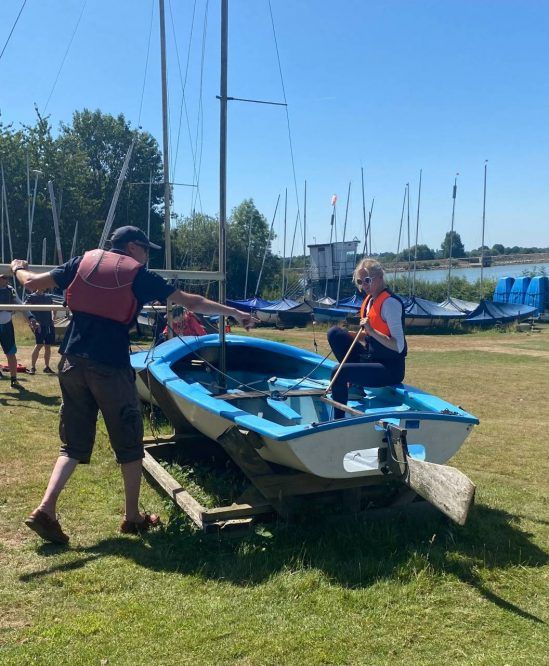
Above: Emma trying to get to grips with tacking. Image via Emma Coady.
Sailing upwind
While gibing may sound like a funky dance move, it is a sailing manoeuvre where the boat turns its stern through the wind while sailing downwind, causing the sail to switch from one side of the boat to the other.
Steps of a jibing manoeuvre
- Helmsman gives the first command, “Ready to jibe?”
- The crew looks 360° around the boat, gets ready to jybe by picking up the new jib sheet, and says, “Ready!”
- Helmsman pulls the mainsail all the way in to reduce the amount of travel for the boom and slows it down.
- Immediately prior to jibing, helmsman heralds, “Jibe Ho!”
- Helmsman pulls the tiller away from the mainsail.
- As the sail switches sides and swings across the boat (90 degrees) the helmsman and crew switch sides.
- Helmsman lets the mainsail back out.
- Once on course, helmsman brings the tiller back to the center of the boat.
- Trim sails and sail away.
Out on the water, our instructor told us to alternate between tacking and gibing. I found myself often confused about the differences. Now that a couple of weeks have passed, I have time to digest the theory.
Key differences between gibing and tacking
Simply put, tacking involves turning the bow (front) of the boat through the wind, while gybing (or jibing) involves turning the stern (back) of the boat through the wind.
The tiller is moved in a different direction, and most importantly, you must pull the mainsail in before you jibe, or you will encounter problems.
Capsize /MOB
This was the part of the course we had all been dreading- but our fears are met with a surprisingly refreshing dip in warm shallow water. Rinsing odd my sports trainers- I realised that it was time to invest in a pair of sailing shoes.
By the end of the course I felt that I was only just getting to grips with the five essentials, but after discussing progress with my classmates- they also felt a little out of their depth. After spending less than six hours on the water, it was to be expected. All that is left to do now, is spend more time out on the water at Banbury Sailing Club. With a highly regarded kids clubs, social nights on Friday evenings with barbecues and beers and a friendly club I was left with one burning question:
Where do I sign up?

Above: My sons Atticus and Austin. Aged one, Atticus was a natural on the tiller. Image via Emma Coady.
If you would like to buy a beginners sailing dinghy, you might be interested in boat buyers guide 25 best beginner sailing dinghies.












